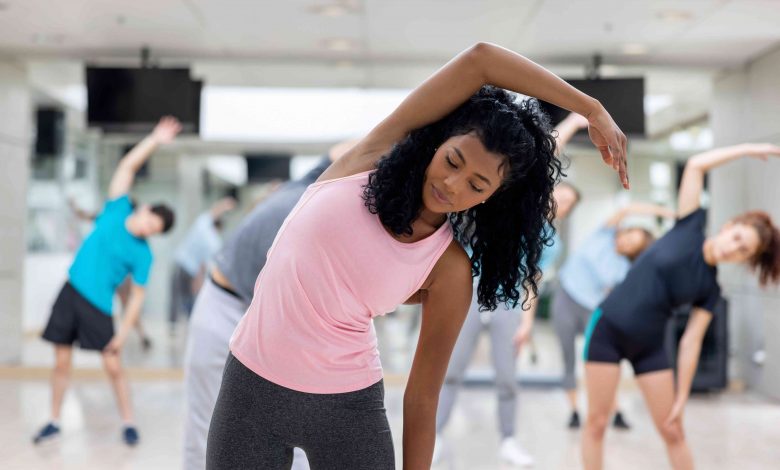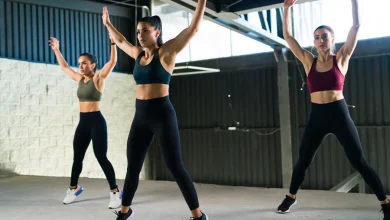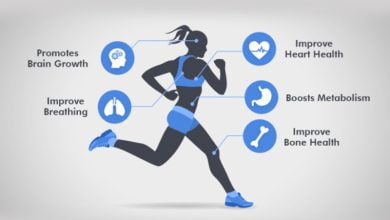
Introduction:
Aerobic exercise, often dubbed as cardio, is a cornerstone of any fitness regimen, and for good reason. It encompasses a wide range of activities that get your heart pumping and your lungs working harder. From brisk walking to cycling, swimming to dancing, aerobic exercises come in many forms, catering to various fitness levels and preferences. This comprehensive approach to fitness has garnered immense popularity due to its myriad of benefits, ranging from improving cardiovascular health to enhancing mood and overall well-being.
Understanding Aerobic Exercise:
At its core, aerobic exercise refers to any activity that increases your heart rate and breathing rate for a sustained period. This sustained effort stimulates the cardiovascular system, leading to improved circulation, increased oxygen delivery to tissues, and enhanced endurance over time. Unlike anaerobic exercises, which focus on short bursts of intense activity (think weightlifting or sprinting), aerobic exercises are characterized by moderate intensity sustained over a longer duration.
Types of Aerobic Exercise:
The beauty of aerobic exercise lies in its versatility. There’s something for everyone, regardless of age, fitness level, or personal preference. Here are some popular types:
Walking:
The simplest form of aerobic exercise, walking requires no special equipment and can be done almost anywhere. Whether it’s a leisurely stroll in the park or a brisk walk around the neighborhood, walking offers numerous health benefits, including improved cardiovascular health, stronger bones, and enhanced mood.
Walking: The Timeless Aerobic Exercise:
Walking, the most fundamental of human movements, holds within it the essence of aerobic exercise. It’s a simple yet profoundly effective activity that has been practiced since time immemorial. From leisurely strolls through nature to brisk power walks in the urban jungle, walking offers a plethora of health benefits while remaining accessible to almost everyone, regardless of age, fitness level, or location.
The Beauty of Walking:
Walking is a form of aerobic exercise that requires no special equipment, no membership fees, and no specific skill set. All you need is a comfortable pair of shoes and the willingness to put one foot in front of the other. This simplicity is perhaps what makes walking so appealing and sustainable in the long term.
Health Benefits:
Despite its simplicity, walking packs a powerful punch when it comes to improving health and well-being. Here are some of the key benefits:
Cardiovascular Health:
Walking gets your heart rate up, improving cardiovascular fitness and reducing the risk of heart disease and stroke. It strengthens the heart muscle, lowers blood pressure, and improves circulation throughout the body.
Weight Management:
Walking burns calories, making it an effective tool for weight loss and weight management when combined with a healthy diet. The number of calories burned depends on factors such as speed, duration, and terrain, but even a leisurely stroll can contribute to calorie expenditure.
Joint Health:
Unlike high-impact activities like running, walking is low-impact and gentle on the joints, making it suitable for people of all ages and fitness levels. It helps improve joint flexibility, reduce stiffness, and alleviate joint pain, making it an ideal exercise for those with arthritis or other joint issues.
Mental Well-being:
Walking isn’t just good for the body; it’s also beneficial for the mind. Spending time outdoors in nature while walking can reduce stress, anxiety, and depression, while boosting mood and overall mental well-being. The rhythmic motion of walking can be meditative, providing a sense of calm and clarity amidst life’s chaos.
Bone Health:
Weight-bearing activities like walking help maintain bone density and reduce the risk of osteoporosis, especially in older adults. Walking regularly strengthens bones, muscles, and connective tissues, promoting overall skeletal health and reducing the risk of fractures and falls.
Longevity:
Studies have shown that regular walking is associated with increased longevity, meaning that those who walk regularly tend to live longer, healthier lives. It’s a simple yet powerful way to invest in your long-term health and vitality.
Incorporating Walking into Your Routine:
The beauty of walking lies in its versatility and adaptability. Whether you’re looking for a leisurely stroll or a more intense workout, there are endless ways to incorporate walking into your daily routine. Here are some tips to help you get started:
Start Slow:
If you’re new to walking or exercise in general, start with shorter distances and gradually increase your pace and duration over time. Listen to your body and don’t push yourself too hard too soon.
Find Your Pace:
Whether you prefer a leisurely stroll or a brisk power walk, find a pace that feels comfortable and sustainable for you. Pay attention to your breathing and aim to maintain a steady rhythm throughout your walk.
Set Goals:
Whether it’s walking a certain number of steps per day, completing a specific route, or increasing your walking speed, set realistic goals to keep you motivated and focused.
Mix It Up:
To keep things interesting and prevent boredom, vary your walking routine by exploring different routes, terrains, and environments. Walk in nature trails, urban parks, or around your neighborhood—each offers its own unique benefits and scenery.
Make It Social:
Walking with a friend, family member, or furry companion can make the experience more enjoyable and motivating. Use it as an opportunity to catch up, connect with loved ones, or simply enjoy each other’s company while getting some exercise.
Stay Consistent:
Like any form of exercise, consistency is key to reaping the full benefits of walking. Aim to walk regularly, ideally at least 30 minutes a day, most days of the week, to maintain and improve your health and fitness levels.
In Conclusion:
Walking is more than just a means of transportation; it’s a powerful form of aerobic exercise that offers a myriad of health benefits for the body, mind, and spirit. Whether you’re aiming to improve cardiovascular health, manage weight, reduce stress, or simply enjoy the great outdoors, walking provides a simple yet effective way to achieve your fitness goals. So lace up your shoes, step outside, and let the rhythm of walking lead you towards a healthier, happier life.
Running:
Taking your cardio up a notch, running provides a higher intensity workout that burns calories and boosts cardiovascular fitness. It’s a great way to challenge yourself, improve endurance, and even participate in races and marathons if you’re inclined.
Running: Harnessing the Power of Motion:
Running, the primal act of propelling oneself forward at speed, is one of the most accessible and effective forms of aerobic exercise. It’s a timeless activity that has captivated humans for centuries, from ancient hunters tracking prey to modern-day athletes striving for peak performance. Whether you’re pounding the pavement in the city streets or traversing rugged trails in the great outdoors, running offers a plethora of physical, mental, and emotional benefits that extend far beyond the finish line.
The Essence of Running:
At its core, running is a simple yet profoundly impactful form of aerobic exercise that engages the entire body in a rhythmic motion. It requires little more than a pair of supportive shoes and the will to move, making it accessible to people of all ages, backgrounds, and fitness levels. Whether you’re a seasoned marathoner or a novice jogger, running offers a sense of freedom, empowerment, and connection to both oneself and the world around you.
Health Benefits:
The health benefits of running are as diverse and far-reaching as the landscapes it traverses. Here are some of the key advantages:
Cardiovascular Fitness:
Running is a highly effective way to improve cardiovascular health, strengthening the heart muscle, improving circulation, and lowering blood pressure. It increases oxygen delivery to tissues, enhances lung capacity, and boosts overall cardiovascular endurance.
Weight Management:
Running burns calories at a high rate, making it an efficient tool for weight loss and weight management when combined with a balanced diet. The intensity of running promotes fat burning and muscle toning, helping to sculpt a leaner, more defined physique over time.
Mental Well-being:
The rhythmic motion of running, combined with the release of endorphins, can have a profound impact on mental health and well-being. It reduces stress, anxiety, and depression, while improving mood, self-esteem, and overall cognitive function. Many runners describe experiencing a “runner’s high,” a euphoric state of mind that comes from the sense of accomplishment and the flood of feel-good chemicals in the brain.
Bone and Joint Health:
Contrary to popular belief, running can actually strengthen bones and joints when practiced responsibly. It helps maintain bone density, reduce the risk of osteoporosis, and improve joint stability and mobility. Proper footwear, gradual progression, and adequate rest are essential for minimizing the risk of injury and maximizing the benefits of running.
Longevity:
Numerous studies have shown that regular running is associated with increased longevity and a reduced risk of chronic diseases such as heart disease, stroke, diabetes, and certain types of cancer. It’s a powerful way to invest in your long-term health and vitality, helping you live a longer, healthier life.
Community and Connection:
Running has a unique ability to bring people together, fostering a sense of camaraderie, community, and connection. Whether it’s through local running clubs, organized races, or virtual challenges, runners often find support, encouragement, and friendship in their fellow athletes, creating bonds that transcend geographic boundaries and cultural differences.
Getting Started:
If you’re new to running or looking to take your running to the next level, here are some tips to help you get started:
Invest in Proper Footwear:
A good pair of running shoes that provide adequate support, cushioning, and stability is essential for preventing injury and ensuring comfort during your runs. Visit a specialty running store to get fitted for the right shoes for your foot type and running style.
Start Slowly:
If you’re new to running, start with a run/walk approach, alternating periods of running with periods of walking to build endurance gradually. Listen to your body and increase the duration and intensity of your runs incrementally over time.
Focus on Form:
Pay attention to your running form, including posture, stride length, and foot strike. Aim for a relaxed, efficient running gait that minimizes stress on your joints and maximizes energy efficiency.
Stay Consistent:
Consistency is key when it comes to improving as a runner. Aim to run regularly, ideally three to four times per week, to build cardiovascular fitness, endurance, and strength. Mix up your runs with different distances, paces, and terrains to keep things interesting and challenging.
Listen to Your Body:
Pay attention to how your body feels during and after your runs. If you experience pain, discomfort, or fatigue, don’t ignore it. Take rest days as needed, cross-train with other activities like swimming or cycling, and incorporate stretching, foam rolling, and strength training to prevent injury and promote recovery.
Set Goals:
Whether it’s completing a 5K race, running a marathon, or simply improving your pace and endurance, set specific, measurable goals to keep you motivated and focused. Break your goals down into smaller milestones and celebrate your progress along the way.
In Conclusion:
Running is more than just a physical activity; it’s a transformative experience that encompasses the body, mind, and spirit. Whether you’re seeking improved fitness, mental clarity, stress relief, or a sense of community, running offers a path to personal growth, empowerment, and self-discovery. So lace up your shoes, step outside, and embrace the rhythm of the run—it may just change your life in ways you never imagined.
Cycling:
Whether you prefer the open road or the comfort of a stationary bike, cycling is an excellent aerobic exercise that targets the lower body while providing a cardiovascular workout. It’s low-impact, making it ideal for those with joint issues or recovering from injury.
Cycling: Pedaling Towards Fitness and Freedom:
Cycling, with its blend of exhilaration and endurance, embodies the essence of aerobic exercise. It’s a versatile activity that offers both physical and mental benefits while allowing riders to explore new landscapes, push their limits, and experience the pure joy of motion. Whether you’re commuting to work, exploring scenic routes, or participating in competitive races, cycling provides a dynamic and rewarding way to improve fitness, boost mood, and enhance overall well-being.
The Allure of Cycling:
Cycling has a universal appeal that transcends age, background, and ability. From children mastering their first two-wheeled adventure to seasoned cyclists tackling epic mountain climbs, the thrill of cycling knows no bounds. Its accessibility, adaptability, and sheer enjoyment make it a popular choice for fitness enthusiasts, outdoor enthusiasts, and commuters alike.
Health Benefits:
The health benefits of cycling are as varied as the terrain it covers. Here are some of the key advantages:
Cardiovascular Fitness:
Cycling is an excellent cardiovascular workout that gets the heart pumping and the blood flowing. It strengthens the heart muscle, improves circulation, and lowers blood pressure, reducing the risk of heart disease, stroke, and other cardiovascular conditions.
Muscle Strength and Endurance:
Cycling engages multiple muscle groups, including the legs, core, and upper body, helping to build strength, power, and endurance. It targets the quadriceps, hamstrings, glutes, and calves, while also activating stabilizing muscles in the core and arms.
Low-Impact Exercise:
Unlike high-impact activities like running, cycling is gentle on the joints, making it suitable for people of all ages and fitness levels. It’s particularly beneficial for those with joint issues, arthritis, or other musculoskeletal conditions who may find weight-bearing exercises too taxing.
Weight Management:
Cycling is an effective way to burn calories and manage weight when combined with a balanced diet. The intensity of cycling can be adjusted to suit individual fitness levels, with options ranging from leisurely rides to high-intensity interval training (HIIT) sessions that torch calories and boost metabolism.
Mental Well-being:
Cycling is not just good for the body; it’s also beneficial for the mind. The rhythmic motion of pedaling, combined with the release of endorphins, can reduce stress, anxiety, and depression, while improving mood, focus, and overall cognitive function.
Improved Lung Function:
Cycling is an aerobic exercise that increases oxygen intake and lung capacity, improving respiratory function and efficiency. Over time, regular cycling can enhance lung health and reduce the risk of respiratory conditions such as asthma and chronic obstructive pulmonary disease (COPD).
Types of Cycling:
Cycling encompasses a wide range of activities, each offering its own unique benefits and experiences. Here are some popular types of cycling:
Road Cycling:
Whether it’s a leisurely ride through the countryside or a challenging climb up a mountain pass, road cycling offers a sense of freedom and adventure on two wheels. It’s a great way to explore new places, connect with nature, and push your limits while enjoying the open road.
Mountain Biking:
For thrill-seekers and outdoor enthusiasts, mountain biking provides an adrenaline-pumping experience through rugged terrain, technical descents, and natural obstacles. It’s a full-body workout that tests agility, balance, and mental focus, offering a unique blend of excitement and challenge.
Commuting:
Cycling isn’t just a recreational activity; it’s also a practical and eco-friendly mode of transportation. Commuting by bike allows you to bypass traffic congestion, reduce carbon emissions, and incorporate physical activity into your daily routine, all while saving money on gas and parking.
Indoor Cycling:
For those who prefer the comfort and convenience of indoor workouts, stationary or indoor cycling provides a high-intensity cardio workout in a controlled environment. It’s a popular option for group fitness classes, spin studios, and home exercise routines, offering a low-impact alternative to outdoor cycling.
Touring and Bikepacking:
For adventurers and explorers, touring and bikepacking offer the opportunity to embark on epic journeys across vast landscapes, from cross-country road trips to multi-day wilderness expeditions. It’s a self-supported adventure that requires careful planning, preparation, and a spirit of adventure.
Getting Started:
If you’re new to cycling or looking to get back in the saddle, here are some tips to help you get started:
Choose the Right Bike:
Select a bike that suits your riding style, fitness goals, and budget. Whether it’s a road bike, mountain bike, hybrid bike, or commuter bike, make sure it fits you properly and is well-maintained for a safe and enjoyable riding experience.
Start Slow:
If you’re new to cycling or returning after a hiatus, start with shorter rides at a comfortable pace and gradually increase your distance and intensity over time. Listen to your body and take rest days as needed to prevent overtraining and burnout.
Focus on Technique:
Pay attention to your cycling technique, including proper body positioning, pedaling mechanics, and gear selection. Practice shifting gears smoothly, maintaining a steady cadence, and using proper braking techniques to maximize efficiency and performance.
Stay Safe:
Wear appropriate safety gear, including a helmet, reflective clothing, and lights if riding at night or in low-light conditions. Obey traffic laws, ride defensively, and use hand signals to communicate with other road users. Stay hydrated, fuel your body with nutritious foods, and carry essentials such as water, snacks, and repair tools on longer rides.
Join a Community:
Cycling is often more enjoyable when shared with others. Join a local cycling club, group ride, or online community to connect with fellow cyclists, share tips and advice, and discover new routes and destinations. Riding with others can provide motivation, accountability, and a sense of camaraderie that enhances the overall cycling experience.
Set Goals:
Whether it’s completing a charity ride, conquering a challenging climb, or simply riding a certain number of miles per week, set specific, measurable goals to keep you motivated and focused. Break your goals down into smaller milestones and celebrate your achievements along the way.
In Conclusion:
Cycling is more than just a mode of transportation or a recreational activity; it’s a lifestyle that promotes health, happiness, and freedom on two wheels. Whether you’re seeking adventure, fitness, stress relief, or a sense of community, cycling offers a dynamic and rewarding experience that can be enjoyed by people of all ages, abilities, and backgrounds. So saddle up, pedal on, and embrace the journey ahead—it may just take you places you’ve never dreamed possible.
Swimming:
Dive into the pool for a full-body workout that’s easy on the joints. Swimming engages multiple muscle groups simultaneously, providing an excellent cardiovascular workout while improving strength, flexibility, and coordination.
Dancing:
Who says exercise has to be boring? Dancing is not only a fun way to get your heart pumping but also a fantastic stress reliever. From salsa to hip-hop, there’s a dance style for everyone, making it a highly enjoyable form of aerobic exercise.
Aerobic Classes:
From step aerobics to Zumba, group fitness classes offer a structured and motivating way to get your cardio fix. These classes often incorporate music, choreography, and camaraderie, making the workout feel more like a dance party than a gym session.
Benefits of Aerobic Exercise:
The benefits of aerobic exercise extend far beyond just burning calories. Here are some key advantages:
Improved Cardiovascular Health:
Aerobic exercise strengthens the heart muscle, lowers blood pressure, and improves circulation, reducing the risk of heart disease and stroke.
Weight Management:
Regular aerobic exercise helps burn calories, aiding in weight loss and weight maintenance when combined with a healthy diet.
Enhanced Mood:
Ever heard of the “runner’s high”? Aerobic exercise stimulates the release of endorphins, neurotransmitters that promote feelings of happiness and well-being, helping to alleviate stress, anxiety, and depression.
Increased Energy Levels:
While it may seem counterintuitive, expending energy through exercise actually boosts energy levels in the long run by improving sleep quality and overall stamina.
Better Cognitive Function:
Aerobic exercise has been shown to enhance cognitive function, including memory, attention, and executive function, while reducing the risk of cognitive decline as we age.
Stronger Immune System:
Regular aerobic exercise can bolster the immune system, reducing the risk of chronic illnesses and infections.
Getting Started:
If you’re new to aerobic exercise or getting back into it after a hiatus, it’s essential to start slowly and gradually increase intensity and duration over time. Here are some tips to help you get started:
Consult with a Healthcare Professional:
If you have any underlying health conditions or concerns, it’s wise to consult with your doctor before starting a new exercise program.
Set Realistic Goals:
Whether it’s completing a 5K run or fitting into your favorite pair of jeans, set achievable goals to keep you motivated and on track.
Find Activities You Enjoy:
The key to sticking with any exercise program is finding activities that you genuinely enjoy. Experiment with different forms of aerobic exercise until you find what works best for you.
Mix It Up:
Variety is the spice of life, and the same holds true for exercise. Incorporate a mix of activities to keep things interesting and prevent boredom or burnout.
Listen to Your Body:
Pay attention to how your body feels during and after exercise. If something doesn’t feel right, scale back or take a break as needed.
Stay Consistent:
Consistency is key when it comes to reaping the benefits of aerobic exercise. Aim for at least 150 minutes of moderate-intensity aerobic activity per week, spread out over several days.
In Conclusion:
Aerobic exercise is a fundamental component of a healthy lifestyle, offering a multitude of physical, mental, and emotional benefits. Whether you’re aiming to improve cardiovascular health, manage weight, boost mood, or simply have fun, there’s an aerobic activity out there for you. So lace up your sneakers, hit the pavement, dive into the pool, or dance like nobody’s watching—your body and mind will thank you for it.




